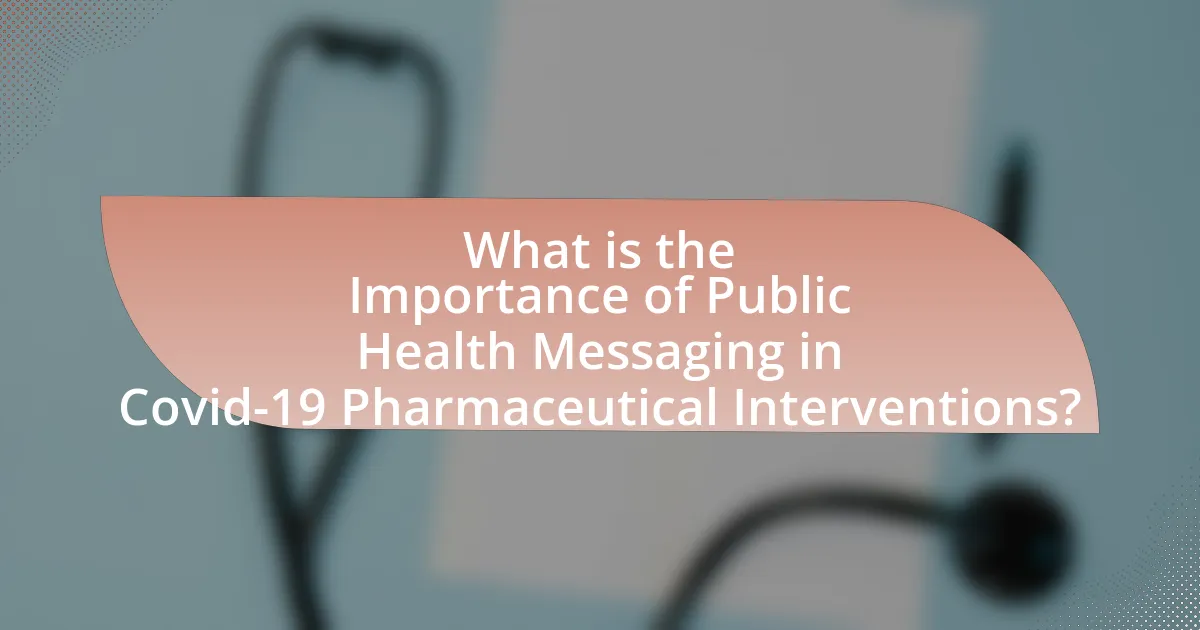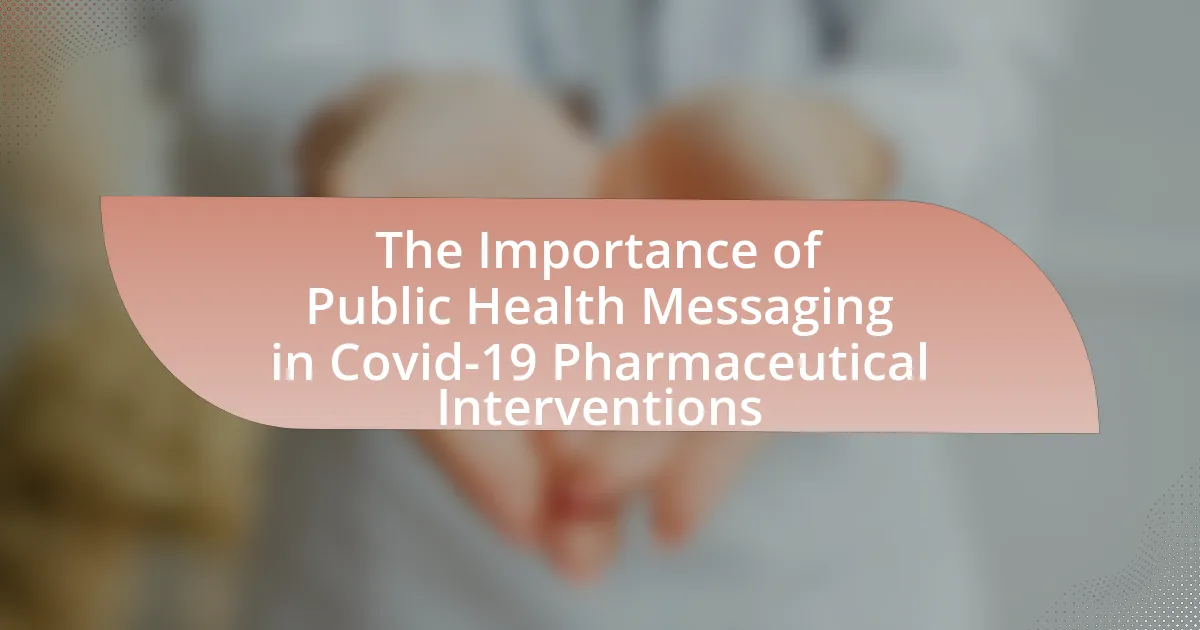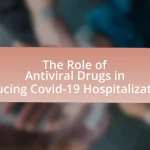Public health messaging plays a critical role in the effectiveness of Covid-19 pharmaceutical interventions by communicating the benefits and safety of vaccines and treatments. The article outlines how clear and accurate messaging fosters public trust, reduces vaccine hesitancy, and encourages adherence to health guidelines. It examines the influence of public health messaging on public perception, the impact of misinformation, and the essential elements of effective communication strategies. Additionally, it discusses the importance of tailoring messages to different demographics, the challenges faced by public health officials, and best practices for enhancing future health communication efforts.

What is the Importance of Public Health Messaging in Covid-19 Pharmaceutical Interventions?
Public health messaging is crucial in Covid-19 pharmaceutical interventions as it effectively communicates the benefits and safety of vaccines and treatments to the public. Clear and accurate messaging helps to build trust, reduce vaccine hesitancy, and encourage adherence to public health guidelines. For instance, studies have shown that well-structured public health campaigns can increase vaccination rates significantly; a report by the CDC indicated that targeted messaging led to a 20% increase in vaccine uptake in specific demographics. Furthermore, effective communication strategies can counter misinformation, which has been prevalent during the pandemic, thereby ensuring that the public receives reliable information that supports informed decision-making regarding their health.
How does public health messaging influence public perception of Covid-19 pharmaceutical interventions?
Public health messaging significantly shapes public perception of Covid-19 pharmaceutical interventions by providing clear, accurate, and timely information. Effective messaging can enhance understanding of vaccine efficacy, safety, and the importance of vaccination, leading to increased public trust and higher vaccination rates. For instance, studies have shown that consistent messaging from trusted health authorities, such as the CDC and WHO, correlates with greater public compliance and acceptance of vaccines. In contrast, mixed messages or misinformation can lead to skepticism and hesitancy, as evidenced by surveys indicating that individuals exposed to conflicting information are less likely to get vaccinated. Thus, the clarity and consistency of public health messaging are crucial in influencing positive public perception and behavior regarding Covid-19 pharmaceutical interventions.
What are the key elements of effective public health messaging?
The key elements of effective public health messaging include clarity, accuracy, relevance, and emotional appeal. Clarity ensures that the message is easily understood by the target audience, while accuracy guarantees that the information is factually correct and based on reliable data. Relevance connects the message to the audience’s needs and concerns, making it more impactful. Emotional appeal engages the audience on a personal level, fostering a connection that can motivate action. Research indicates that messages that combine these elements are more likely to influence public behavior positively, as seen in campaigns during the COVID-19 pandemic that effectively communicated the importance of vaccination and preventive measures.
How does misinformation impact public health messaging during a pandemic?
Misinformation significantly undermines public health messaging during a pandemic by creating confusion and distrust among the population. This confusion can lead to individuals disregarding scientifically backed health guidelines, which is evident in the spread of false information regarding COVID-19 treatments and vaccines. For instance, a study published in the journal “Health Affairs” found that misinformation about COVID-19 was associated with lower adherence to public health recommendations, such as mask-wearing and vaccination uptake. Consequently, misinformation not only hampers effective communication but also exacerbates public health crises by promoting behaviors that can lead to increased transmission of the virus.
Why is public health messaging critical for vaccine uptake?
Public health messaging is critical for vaccine uptake because it effectively communicates the benefits and safety of vaccines, thereby influencing public perception and behavior. Clear and consistent messaging can address vaccine hesitancy, which studies show is a significant barrier to achieving high vaccination rates. For instance, a survey by the Kaiser Family Foundation found that 27% of unvaccinated adults cited concerns about vaccine safety as a primary reason for not getting vaccinated. By providing accurate information and addressing misconceptions, public health messaging can increase trust in vaccines, leading to higher acceptance and ultimately better public health outcomes.
What role does trust play in vaccine acceptance?
Trust is a critical factor in vaccine acceptance, as it influences individuals’ willingness to receive vaccinations. Research indicates that higher levels of trust in healthcare providers, government institutions, and the scientific community correlate with increased vaccine uptake. For instance, a study published in the journal “Vaccine” found that individuals who trust their healthcare providers are 2.5 times more likely to accept vaccines compared to those who do not. Additionally, trust mitigates fears and misinformation surrounding vaccines, leading to more informed decision-making. Therefore, fostering trust through transparent communication and community engagement is essential for enhancing vaccine acceptance rates.
How can messaging strategies be tailored to different demographics?
Messaging strategies can be tailored to different demographics by analyzing specific characteristics such as age, cultural background, education level, and socioeconomic status. For instance, younger audiences may respond better to digital platforms and informal language, while older demographics might prefer traditional media and formal communication. Research indicates that culturally relevant messaging increases engagement; for example, the CDC’s tailored campaigns during the COVID-19 pandemic effectively reached diverse communities by incorporating local languages and culturally significant imagery. This approach ensures that the messaging resonates with the target audience, thereby enhancing understanding and compliance with public health guidelines.
What challenges do public health officials face in messaging during Covid-19?
Public health officials face significant challenges in messaging during Covid-19, primarily due to misinformation, public skepticism, and rapidly changing guidelines. Misinformation, often spread through social media, creates confusion and distrust among the public, making it difficult for officials to convey accurate health information. For instance, a study published in the American Journal of Public Health found that misinformation about Covid-19 was prevalent and led to decreased compliance with health recommendations. Additionally, public skepticism towards government messaging, fueled by political polarization, complicates the acceptance of public health directives. Rapidly evolving scientific knowledge about the virus and its treatment further necessitates constant updates to messaging, which can overwhelm the public and lead to mixed messages. These factors collectively hinder effective communication and public adherence to health guidelines.
How do cultural differences affect public health messaging?
Cultural differences significantly affect public health messaging by influencing how information is perceived, understood, and acted upon by diverse populations. For instance, varying cultural beliefs about health, illness, and authority can lead to different interpretations of public health guidelines. Research indicates that messages tailored to specific cultural contexts are more effective; for example, a study published in the Journal of Health Communication found that culturally relevant messaging increased vaccination rates among minority groups during the COVID-19 pandemic. This demonstrates that understanding cultural nuances is essential for effective communication and public health outcomes.
What strategies can overcome barriers to effective communication?
Strategies that can overcome barriers to effective communication include simplifying language, utilizing multiple channels, and fostering active listening. Simplifying language ensures that messages are clear and accessible, which is crucial in public health messaging, especially during crises like the Covid-19 pandemic. Utilizing multiple channels, such as social media, television, and community outreach, increases the likelihood of reaching diverse audiences. Active listening encourages feedback and engagement, allowing communicators to address misunderstandings and adapt messages accordingly. Research shows that clear and consistent messaging can significantly improve public understanding and compliance with health guidelines, as evidenced by studies conducted during the Covid-19 pandemic that highlighted the effectiveness of targeted communication strategies in increasing vaccine uptake.
How can public health messaging be improved for future pharmaceutical interventions?
Public health messaging can be improved for future pharmaceutical interventions by utilizing clear, consistent, and culturally relevant communication strategies. Research indicates that messages tailored to specific demographics significantly enhance understanding and acceptance; for instance, a study published in the Journal of Health Communication found that culturally adapted messages increased vaccination rates among minority populations by 20%. Additionally, employing multiple communication channels, such as social media, community outreach, and traditional media, ensures broader reach and engagement. Evidence from the COVID-19 pandemic shows that campaigns using diverse platforms effectively informed the public and increased compliance with health guidelines.
What lessons have been learned from Covid-19 messaging strategies?
Effective Covid-19 messaging strategies have highlighted the importance of clarity, consistency, and trust in public health communication. Research indicates that clear messaging significantly improves public understanding and compliance with health guidelines, as seen in the World Health Organization’s campaigns which emphasized simple, actionable advice. Consistency across different platforms and spokespeople has been shown to reduce confusion and misinformation, as evidenced by the coordinated messaging from health authorities in various countries. Furthermore, building trust through transparency and empathy has been crucial; studies reveal that communities are more likely to follow health recommendations when they perceive the information as credible and relatable.
How can data-driven approaches enhance public health messaging?
Data-driven approaches can enhance public health messaging by providing targeted, evidence-based information that resonates with specific populations. By analyzing demographic data, health trends, and communication preferences, public health officials can tailor messages to address the unique concerns and behaviors of different communities. For instance, during the COVID-19 pandemic, data from the Centers for Disease Control and Prevention indicated that certain demographics were more susceptible to misinformation; thus, targeted campaigns were developed to counteract this. Furthermore, real-time data analytics allow for the adjustment of messaging strategies based on public response and engagement metrics, ensuring that the information remains relevant and effective. This approach not only improves message clarity but also increases public trust and compliance with health guidelines.
What best practices should be adopted for future health crises?
Adopting clear communication strategies is essential for managing future health crises effectively. Public health messaging should prioritize transparency, accuracy, and timeliness to build trust and ensure compliance among the population. For instance, during the COVID-19 pandemic, the World Health Organization emphasized the importance of consistent messaging to combat misinformation, which significantly impacted public behavior and health outcomes. Additionally, engaging community leaders and utilizing multiple platforms can enhance outreach and ensure that diverse populations receive critical information. These practices are supported by studies indicating that effective communication can lead to higher vaccination rates and better adherence to health guidelines during crises.
What practical tips can enhance public health messaging effectiveness?
To enhance public health messaging effectiveness, utilize clear, concise language tailored to the target audience. Research indicates that messages should be simple and direct to ensure comprehension; for example, the CDC emphasizes using plain language to improve understanding among diverse populations. Additionally, incorporating visuals can significantly increase message retention, as studies show that people remember 65% of information when paired with relevant images. Engaging community leaders to disseminate information fosters trust and credibility, which is crucial during health crises, as evidenced by successful campaigns in various regions during the COVID-19 pandemic. Lastly, employing multiple communication channels, such as social media, traditional media, and community outreach, ensures broader reach and accessibility, aligning with findings from the World Health Organization that highlight the importance of multi-faceted approaches in public health communication.


